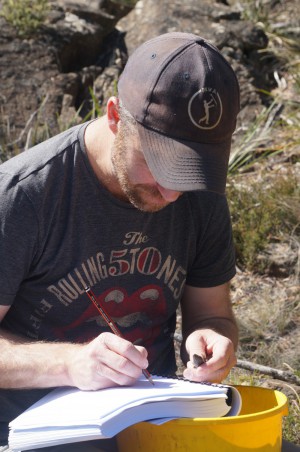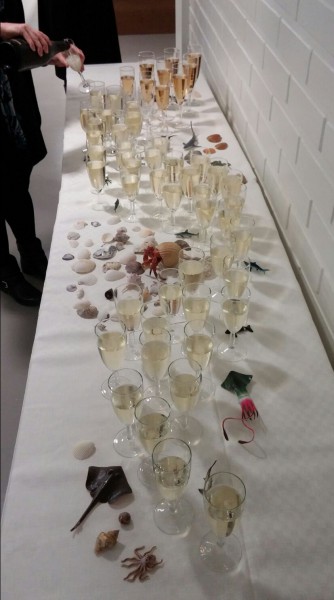Fieldwork in Australia
Tobias and Nathalie have spent the last three weeks in the field in Australia working on an ARC funded project on the evolution of social complexity in lizards. The project is a collaboration led by Geoff While at the University of Tasmania, which also involves Charlie Cornwallis in Lund and several research groups in Australia.

Geoff measuring lizards
Our aim is to understand early transitions to family life. Most lizards have limited interactions with close kin, but in the Egernia group some species form lasting pair bonds and have offspring that stay at home. In the most extreme cases this leads to multiple overlapping generations and large communities of more or less related individuals that share dwellings, often complex systems of crevices or burrows, which are inherited down generations. This quick guide in Current Biology covers the basics.
A great advantage of Egernia is that we can address the causes of variation in social complexity at three different levels – within populations, among populations, and among species. On this trip we have visited some study sites and species that were new to us. Outside Albury Julia Riley showed us the study site for her PhD project on tree skinks (Egernia striolata), supervised by Martin Whiting and Dan Noble. In the Australian Alps we were given a tour of Guthega skink (Liopholis guthega) sites by Zak Atkins. Guthega skinks are only found in a few high elevation (>1600 m) sites. Zak’s project, which is supervised by Kylie Robert in collaboration with David Chapple, provides important data for comparative analyses of the causes of social complexity in Egernia. He is also revealing some very interesting aspects of the species’ thermal biology, among other things.
 Guthega skinks live in the high country
Guthega skinks live in the high country
The last two weeks were spent lecturing at the University of Tasmania and field working in the eastern and south-western parts of the state. It is on Tasmania we find the main study species, White’s skink (Liopholis whitii). We – or rather Geoff and his students – make use of field, enclosure, and laboratory experiments to understand the evolutionary causes and consequences of social complexity. Although it was too hot for skinks at times, we caught a lot of lizards and had many good nature experiences, including close encounters with penguins.
Read More
Hanna is now Dr Hanna Laakkonen!
 With expected ease and elegance Hanna defended her PhD thesis at the University of Helsinki on November 27, followed by a traditional Finnish party.
With expected ease and elegance Hanna defended her PhD thesis at the University of Helsinki on November 27, followed by a traditional Finnish party.
In her thesis, Hanna used molecular markers to establish the extent to which fish and invertebrate fauna of the Northern Pacific and Atlantic Oceans have exchanged genetic material. These data reveal a remarkable variation among taxa and in 30% of case studies could she establish more than one trans-Arctic invasion. Hanna’s work is a massive effort that synthesizes data from more than 70 taxa and shows that animal movement in this part of the world has been more dynamic than previously believed. Most chapters are published but the thesis itself can be found here. Many congratulations, Hanna!
Read More
